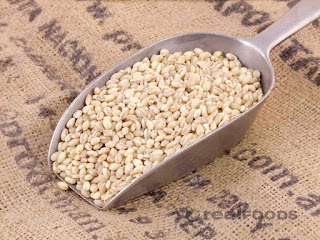Dutch researchers used a crossover study with 10 healthy men to compare the effects of cooked barley kernels and refined wheat bread on blood sugar control. The men ate one or the other of these grains at dinner, then were given a high glycemic index breakfast (50g of glucose) the next morning for breakfast. When they had eaten the barley dinner, the men had 30% better insulin sensitivity the next morning after breakfast.
Lowers Glucose Levels
White rice, the staple food in Japan, is a high glycemic index food. Researchers at the University of Tokushima found that glucose levels were lower after meals when subjects switched from rice to barley.
Scientists at the Functional Food Centre at Oxfod Brookes University in England fed 8 healthy human subjects chapatis (unleavened Indian flatbreads) made with either 0g, 2g, 4g, 6g or 8g of barley beta-glucan fiber. They found that all amounts of barley beta-glucan lowered the glycemic index of the breads, with 4g or more making a significant difference.
Insulin Response better with Barley Beta-Glucan
In a crossover study involving 17 obese women at increased risk for insulin resistance, USDA scientists studied the effects of 5 different breakfast cereal test meals on subjects’ insulin response. They found that consumption of 10g of barley beta-glucan significantly reduced insulin response.
.
Beats Oats in Glucose Response Study
USDA researchers fed barley flakes, barley flour, rolled oats, oat flour, and glucose to 10 overweight middle-aged women, then studied their bodies’ responses. They found that peak glucose and insulin levels after barley were significantly lower than those after glucose or oats. Particle size did not appear to be a factor, as both flour and flakes had similar effects.
Reduces Blood Pressure
For five weeks, adults with mildly high cholesterol were fed diets supplemented with one of three whole grain choices: whole wheat/brown rice, barley, or whole wheat/brown rice/barley. All three whole grain combinations reduced blood pressure, leading USDA researchers to conclude that "in a healthful diet, increasing whole grain foods, whether high in soluble or insoluble fiber, can reduce blood pressure and may help to control weight."
Lowers Serum Lipids
University of Connecticut researchers reviewed 8 studies evaluating the lipid-reducing effects of barley. They found that eating barley significantly lowered total cholesterol, LDL (“bad”) cholesterol, and triglycerides, but did not appear to significantly alter HDL (“good”) cholesterol.
Cholesterol and Visceral Fat Decrease with Barley
A randomized double-blind study in Japan followed 44 men with high cholesterol for twelve weeks, as the men ate either a standard white-rice diet or one with a mixture of rice and high-beta-glucan pearl barley. Barley intake significantly reduced serum cholesterol and visceral fat, both accepted markers of cardiovascular risk.
Significantly Improves Lipids
25 adults with mildly high cholesterol were fed whole grain foods containing 0g, 3g or 6g of barley beta-glucan per day for five weeks, with blood samples taken twice weekly. Total cholesterol and LDL (“bad”) cholesterol significantly decreased with the addition of barley to the diet.
Barley Pasta Lowers Cholesterol
University of California researchers fed two test meals to 11 healthy men, both containing beta-glucan. One meal was a high-fiber (15.7g) barley pasta and the other was lower-fiber (5.0g) wheat pasta. The barley pasta blunted insulin response, and four hours after the meal, barley-eaters had significantly lower cholesterol concentration than wheat-eaters.
Slow Digestion may help Weight Control
Reduces Blood Pressure
For five weeks, adults with mildly high cholesterol were fed diets supplemented with one of three whole grain choices: whole wheat/brown rice, barley, or whole wheat/brown rice/barley. All three whole grain combinations reduced blood pressure, leading USDA researchers to conclude that "in a healthful diet, increasing whole grain foods, whether high in soluble or insoluble fiber, can reduce blood pressure and may help to control weight."
Lowers Serum Lipids
University of Connecticut researchers reviewed 8 studies evaluating the lipid-reducing effects of barley. They found that eating barley significantly lowered total cholesterol, LDL (“bad”) cholesterol, and triglycerides, but did not appear to significantly alter HDL (“good”) cholesterol.
Cholesterol and Visceral Fat Decrease with Barley
A randomized double-blind study in Japan followed 44 men with high cholesterol for twelve weeks, as the men ate either a standard white-rice diet or one with a mixture of rice and high-beta-glucan pearl barley. Barley intake significantly reduced serum cholesterol and visceral fat, both accepted markers of cardiovascular risk.
Significantly Improves Lipids
Barley Pasta Lowers Cholesterol
University of California researchers fed two test meals to 11 healthy men, both containing beta-glucan. One meal was a high-fiber (15.7g) barley pasta and the other was lower-fiber (5.0g) wheat pasta. The barley pasta blunted insulin response, and four hours after the meal, barley-eaters had significantly lower cholesterol concentration than wheat-eaters.
Slow Digestion may help Weight Control
Barley varieties such as Prowashonupana that are especially high in beta-glucan fiber may digest more slowly than standard barley varieties. Researchers at USDA and the Texas Children’s Hospital compared the two and concluded that Prowashonupana may indeed be especially appropriate for obese and diabetic patients.
Greater Satiety, Fewer Calories Eaten with Barley
In a pilot study not yet published, six healthy subjects ate a 420-calorie breakfast bar after an overnight fast, then at lunch were offered an all-you-can-eat buffet. When subjects ate a Prowashonupana barley bar at breakfast they subsequently ate 100 calories less at lunch than when they ate a traditional granola bar for breakfast.
Greater Satiety, Fewer Calories Eaten with Barley
In a pilot study not yet published, six healthy subjects ate a 420-calorie breakfast bar after an overnight fast, then at lunch were offered an all-you-can-eat buffet. When subjects ate a Prowashonupana barley bar at breakfast they subsequently ate 100 calories less at lunch than when they ate a traditional granola bar for breakfast.

















